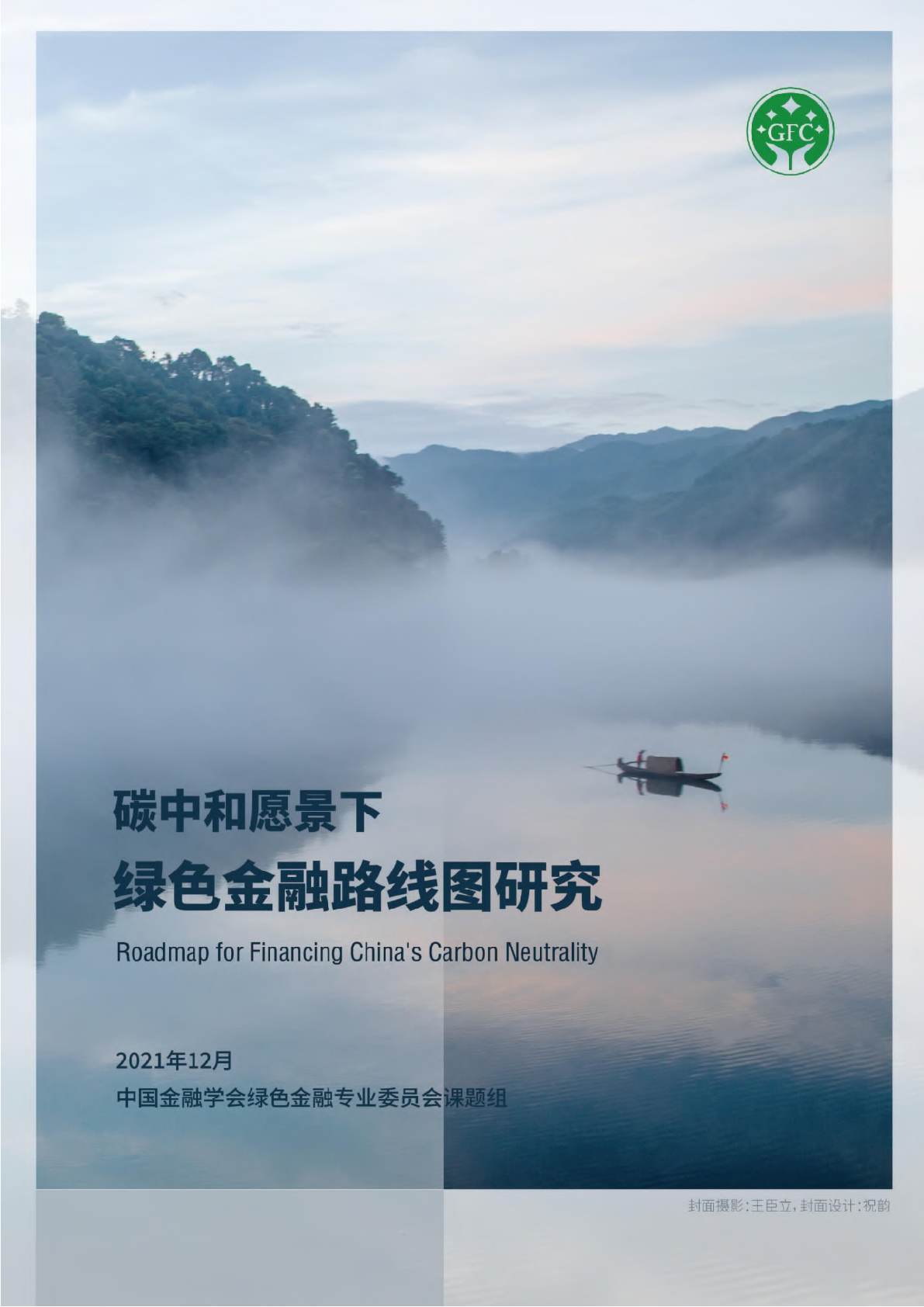Roadmap for Green Finance with Carbon Neutrality Vision

Title: Roadmap for Green Finance with Carbon Neutrality Vision
Release Date: December, 2021

Introduction
On December 3, 2021, the International Symposium on Green Finance was jointly organized by the Beijing Institute of Green Finance and Sustainable Development (IFS) and other institutions. Ma Jun, the director of IFS and Green Finance Committee (GFC) of the China Society of Finance and Banking, released a 201-page report of the research project titled “Roadmap for Green Finance with Carbon Neutrality Vision” on behalf of the GFC working group.
Earlier at the annual meeting of the GFC held in September 2021, the working group released an abbreviated version of the report. In comparison, the newly-released full report provides more contents and background information in the following aspects:
1. The report provides a comprehensive and detailed explanation of China’s decarbonization pathways under both the "existing policy scenario" and the "carbon neutrality scenario", as well as their respective impacts on various industries in China. It explicitly points out a series of additional policy measures and technologies are needed to achieve the carbon neutrality goal.
2. The report predicts that as China endeavors to achieve carbon neutrality, its cumulative demand for green and low-carbon investment in the next three decades will reach 487 trillion yuan (at constant 2018 prices). Based on models such as Energy Policy Simulator (EPS), the report adopts an approach consistent with "Green Industries Guidance Catalogue”. It provides a detailed introduction to the methodology for the estimation and highlights the differences in the scope of prediction between this report and other institutions’.
3. The report categorizes its analysis in seven fields, namely banking, capital market, insurance, institutional investor, carbon market, financial technology, and transition finance. For each field, the report summarizes domestic and international experiences in financial support for carbon reduction, analyzes the gap in green financial system between the current situation and the requirements to achieve carbon neutrality, and puts forward dozens of specific suggestions for Chinese financial institutions. These suggestions include improving Environmental, Social, and Governance (ESG) mechanisms, enhancing climate risk analysis and management capacity, promoting financial product innovation to support low-carbon industries, improving environmental and climate information disclosure, exploring transition financial models, and utilizing digital technology to empower green financial services.
4. The report also introduces the research achievements of the Network for Greening the Financial System (NGFS), an international network of central banks and financial supervisors, regarding methods for environmental risks analysis. It showcases several domestic and international case studies on transition risks. The report emphasizes that after identifying and quantifying climate risks, financial institutions need to disclose them appropriately and take proactive measures to manage climate risks. Financial institutions can establish a climate risk management framework with focus on the following aspects:
1) Incorporating climate risk consideration into governance mechanisms
2) Setting specific targets to reduce climate risk exposure
3) Improving pre-investment and pre-lending risk assessments
4) Adjusting asset risk weights based on environmental and climate risks
5) Promoting the low-carbon transition of high-carbon enterprises/assets
6) Hedging risks associated with high-carbon assets.
5. The report proposes seven specific suggestions to improve the policy framework of green finance, including
1) Revising green finance standards based on the "Do No Significant Harm" principle (DNSH)
2) Providing guidance to financial institutions on calculating and disclosing the disclosure of high-carbon assets and the carbon footprint of major assets
3) Encouraging and requiring financial institutions to conduct environmental and climate risk analysis
4) Establishing stronger incentive mechanism for green finance
5) Encouraging sovereign wealth funds to engage in ESG investments
6) Enhancing the management of environmental and climate risks in overseas investments by financial institutions
7) Improving the regulatory mechanisms for carbon markets.
6. The report points out that in the process of implementing the “decarbonization supporting tools”, special attention should be given to address the following operational issues:
1) Clearly defining the purpose of loans, including project finance, working capital loans, trade financing, and other loan types that align with the investment direction.
2) Issuing disclosure standards for decarbonization tools. Specifically for carbon reduction loans, the standards should clarify how the decarbonization volume is calculated and provide guidance to financial institutions to establish practical and traceable calculation methods and disclosure processes.
3) Selecting qualified third-party institutions and managing them with a list from which commercial banks to choose, or specifying the standards that third-party institutions must meet.
7. The report also provides a series of columns and attachments regarding to
1) Methods of estimating green investment demand,
2) Methods of defining brown assets,
3) Case studies on calculating carbon emissions from bank credit,
4) Case studies on carbon neutrality in financial institutions' own business operations,
5) Case studies on adjusting the risk weights of bank assets based on environmental benefits,
6) Domestic and international cases on climate information disclosure, ESG product innovation, and ESG investment decision-making processes.
Ma Jun stated that the research project "Roadmap for Green Finance with Carbon Neutrality Vision" took one year to finish. The project team consisted of over 40 experts from GFC, and it incorporated the latest research findings from various financial institutions such as banks, insurance companies, securities firms, and funds.
So far, this report is the most comprehensive and in-depth domestic research on how green finance can support carbon neutrality. The forward-looking report not only examines domestic situations and innovative experiences, but also learns from international best practices and takes into account the directions proposed by international policy organizations such as the G20 and NGFS.


